- Clone
- TKS-1 (See other available formats)
- Regulatory Status
- RUO
- Other Names
- 4-1BBL, CD137L, TNFSF9, 4-1BB Ligand
- Isotype
- Rat IgG2a, κ
- Ave. Rating
- Submit a Review
- Product Citations
- publications
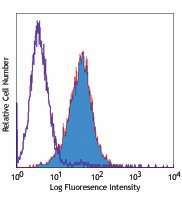
-

Mouse B cell line 2PK3 stained with biotinylated TKS-1, followed by Sav-PE
| Cat # | Size | Price | Quantity Check Availability | Save | ||
|---|---|---|---|---|---|---|
| 107103 | 50 µg | 83 CHF | ||||
4-1BB ligand, also known as CD137L, is a 97 kD member of the TNF superfamily present on antigen-presenting cells (dendritic cells and macrophages) and activated B and T lymphocytes. 4-1BBL interacts with 4-1BB (CD137) to induce T and B cell costimulation.
Product DetailsProduct Details
- Verified Reactivity
- Mouse
- Antibody Type
- Monoclonal
- Host Species
- Rat
- Immunogen
- BALB/c mouse B lymphoma line 2PK-3
- Formulation
- Phosphate-buffered solution, pH 7.2, containing 0.09% sodium azide.
- Preparation
- The antibody was purified by affinity chromatography, and conjugated with biotin under optimal conditions.
- Concentration
- 0.5 mg/ml
- Storage & Handling
- The antibody solution should be stored undiluted between 2°C and 8°C. Do not freeze.
- Application
-
FC - Quality tested
- Recommended Usage
-
Each lot of this antibody is quality control tested by immunofluorescent staining with flow cytometric analysis. For flow cytometric staining, the suggested use of this reagent is ≤0.25 µg per million cells in 100 µl volume. It is recommended that the reagent be titrated for optimal performance for each application.
- Application Notes
-
The TKS-1 antibody inhibits binding of soluble 4-1BB to 4-1BBL in vitro. Additional reported applications (for the relevant formats) include: in vitro blocking the binding of 4-1BB to 4-1BBL1. For most successful immunofluorescent staining results, it may be important to maximize signal over background by using a relatively bright fluorochrome-antibody conjugate (Cat. No. 107106) or by using a high sensitivity, three-layer staining technique (e.g., including a biotinylated antibody (Cat. No. 107104) or biotinylated anti-rat IgG second step (Cat. No. 405402), followed by SAv-PE (Cat. No. 405204)). The LEAF™ purified antibody (Endotoxin <0.1 EU/µg, Azide-Free, 0.2 µm filtered) is recommended for functional assays (Cat. No. 107108).
-
Application References
(PubMed link indicates BioLegend citation) - Product Citations
-
- RRID
-
AB_313304 (BioLegend Cat. No. 107103)
Antigen Details
- Structure
- NGF/TNF superfamily, 97 kD
- Distribution
-
Activated B cells and T cells, macrophages, and dendritic cells
- Function
- T cell costimulation
- Ligand/Receptor
- 4-1BB (CDw137)
- Cell Type
- B cells, Dendritic cells, Macrophages, T cells
- Biology Area
- Costimulatory Molecules, Immunology
- Molecular Family
- CD Molecules
- Antigen References
-
1. Pollok KE, et al. 1995. Eur. J. Immunol. 25:488.
2. DeBenedette MA, et al. 1997. J. Immunol. 158:551.
3. Pollok KE, et al. 1993. J. Immunol. 150:771.
4. Pollok KE, et al. 1994. Eur. J. Immunol. 24:367.
5. Goodwin RG, et al. 1993. Eur. J. Immunol. 23:2631. - Gene ID
- 21942 View all products for this Gene ID
- UniProt
- View information about CD137L on UniProt.org
Related FAQs
- How many biotin molecules are per antibody structure?
- We don't routinely measure the number of biotins with our antibody products but the number of biotin molecules range from 3-6 molecules per antibody.
Other Formats
View All CD137L Reagents Request Custom Conjugation| Description | Clone | Applications |
|---|---|---|
| Biotin anti-mouse 4-1BB Ligand (CD137L) | TKS-1 | FC |
| PE anti-mouse 4-1BB Ligand (CD137L) | TKS-1 | FC |
| Ultra-LEAF™ Purified anti-mouse 4-1BB Ligand (CD137L) | TKS-1 | FC,Block |
Customers Also Purchased
Compare Data Across All Formats
This data display is provided for general comparisons between formats.
Your actual data may vary due to variations in samples, target cells, instruments and their settings, staining conditions, and other factors.
If you need assistance with selecting the best format contact our expert technical support team.
-
Biotin anti-mouse 4-1BB Ligand (CD137L)

Mouse B cell line 2PK3 stained with biotinylated TKS-1, foll... -
PE anti-mouse 4-1BB Ligand (CD137L)
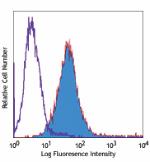
Mouse B cell line 2PK3 stained with TKS-1 PE -
Ultra-LEAF™ Purified anti-mouse 4-1BB Ligand (CD137L)
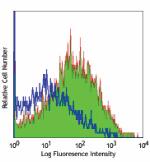
LPS-stimulated Balb/c mouse splenocytes stained with Ultra-L...
 Login / Register
Login / Register 






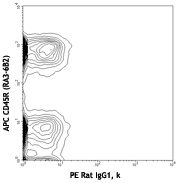

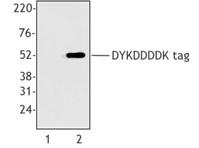
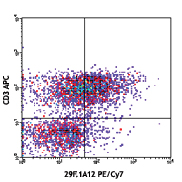



Follow Us